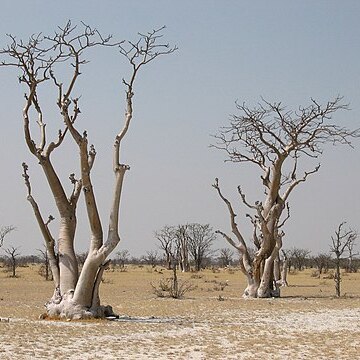Trees or shrubs; glabrous or puberulent; roots tuberous [massive, fibrous, or shrubs canelike with underground tubers], (producing glucosinolates and isothiocyanates, especially in roots and leaves; strongly odoriferous). Stems erect to pendent; unbranched [branched]. Leaves (drought-deciduous) alternate, (imparipinnate), compound; stipules present (glandular); petiole present; leaflets opposite, blade margins entire. Inflorescences axillary, paniculate, with (2-)3-4(-5) orders of branching; bracts (and bracteoles) usually present (glandular). Pedicels present. Flowers strongly zygomorphic [nearly actinomorphic]; perianth and androecium perigynous; sepals 5, distinct; petals 5 (bannerlike petal borne abaxially), distinct; stamens 5, opposite petals (inserted on rim of hypanthium); staminodes [3-]5, similar to filaments, alternate with stamens; anthers monothecal, bisporangiate; ovary 3-carpellate, 1-locular, (on gynophore); placentation probably marginal (sometimes interpreted as medial); ovules anatropous; style 1 (hollow, with a gaping stigmatic aperture). Fruits capsular, valvate, laxly dehiscent, fibrous. Seeds 10-35, brown, globular, winged or not; cotyledons oily.
Trees, shrubs, or herbs, deciduous, massive to slender, tuberous when young and sometimes as adults; bark and pith with gum canals. Leaves alternate, 1-3(or 4)-imparipinnate, glabrous to puberulent; leaflets opposite, entire, sometimes caducous; stipules absent but stalked glands present at base of petiole and leaflets. Flowers borne in axillary panicles, bisexual, white to yellow or red, actinomorphic to zygomorphic, with or without hypanthium. Sepals 5, often reflexed at anthesis. Petals 5, equal or unequal, often reflexed. Stamens in 2 series, 5 perfect and 5 reduced to staminodes; filaments free. Pistil 1; ovary superior, borne on short gynophore, 1-loculed; placentas 3, parietal; ovules numerous; style 1; stigma minute. Fruit a capsule, 3-12-ribbed, sometimes with elongated beak; valves 3, dehiscent. Seeds numerous, 3-winged or wingless, without endosperm.
Trees or shrubs with gummy bark and massive underground rootstocks. Leaves deciduous, alternate, compound once to thrice pinnate; pinnae opposite; leaflets opposite; stipules present as stipitate glands or absent. Flowers bisexual, actinomorphic or zygomorphic, in axillary panicles. Calyx tube short; lobes 5, unequal or almost equal, spreading or reflexed. Petals 5, unequal. Stamens 5, alternating with 5 staminodes, inserted on margin of disc; filaments free; anthers dorsifixed, unilocular, opening by slits. Ovary stipitate, unilocular; placentas 3, parietal; ovules numerous; style terminal, slender, truncate. Fruit a capsule, elongate, beaked, 3–6-angled, 3-valved. Seeds 3-winged or wingless; endosperm absent; embryo straight.
Stamens inserted on the margin of the disk, declinate, 5 perfect, alternating with the same number of antherless stamens or reduced to setae; filaments free; anthers dorsifixed, 1-celled, opening lengthwise by a slit
Ovary stipitate, terete, villous, curved, 1-celled, with 3 parietal placentas; style terminal, slender, tubular, truncate at the apex; ovules numerous, in 2 series on each placenta
Leaves deciduous, alternate, 2–3 times pinnate, pinnae opposite; stipules none, or represented by stipitate glands at the base of the petioles and pinnae
Calyx-tube short, with 5 unequal spreading or reflexed lobes, the fifth posticous, imbricate
Petals 5, the two upper smaller, the lateral ones ascending, the anticous larger
Flowers in axillary panicles, white or red, hermaphrodite, zygomorphic
Capsule long, beaked, 3–6-angled, torulose, 1-celled, 3-valved
Seeds 3-winged or not; embryo without endosperm, straight
Disk lining the calyx-tube, with a short free margin
Trees with gummy bark

